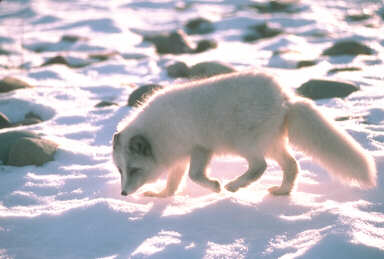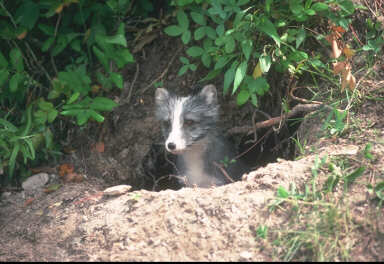
 |
| An arctic fox in it's familiar white, winter coat. |
Though it is not as large or strikingly coloured as the red fox (Vulpes vulpes), the arctic fox´s adaptations to it´s northern environment have nevertheless produced a remarkable animal. It is believed that the species evolved from the swift fox (Vulpes velox) about a quarter of a million years ago, which would make it the youngest of the vulpine fox species. With regards to its taxonomic classification, it seems likely that the arctic fox will eventually be placed into the genus Vulpes. A fair amount of information on this species is available, due to its value both as a fur bearer and as an environmental indicator in the arctic.
 |
| An arctic fox stalks the tundra in it's summer coat. |
A small animal, adults range between 75 and 115cm in length, including a tail approximately 32cm long. Mass varies between 2.5 to 9kg with the males being slightly heavier. The arctic fox´s body structure is typically vulpine, however the extremities are smaller to conserve body heat. Small, rounded ears, a sharply tapered snout, and proportionally short legs are characteristic of the species. The eyes are heavily pigmented to protect them from the extreme glare of light off the arctic ice.
The arctic fox demonstrates an amazing resilience to cold. Studies have shown that its metabolic rate does not even begin to increase until temperatures reach -50C; the animal does not even realize it´s cold until this point! Shivering begins at about -70C, and experiments have shown that it can survive exposure to temperatures down to -80C.
 |
| A blue phase arctic fox in it's summer coat looks out from it's den. |
The arctic fox possesses the warmest fur of any animal. Even the soles of it´s feet are protected by long hairs. Two colour phases are known. In the white phase a short, brownish-grey coat between July and November gives way to longer, dense white fur during the winter. The blue phase is dark bluish-grey or brown in the summer and bluish-grey or bluish-black in the winter. Colour phase is linked to habitat with the blue phase being predominant along shorelines. In Iceland, all foxes show this phase. Half of Greenland´s fox population and 90% of the Pribilof Islands in Alaska also show the blue colour phase. The majority of this species in other areas displays the white phase. Less than 5% of Canada´s arctic fox population exhibits blue colouring.
| Table of Contents |